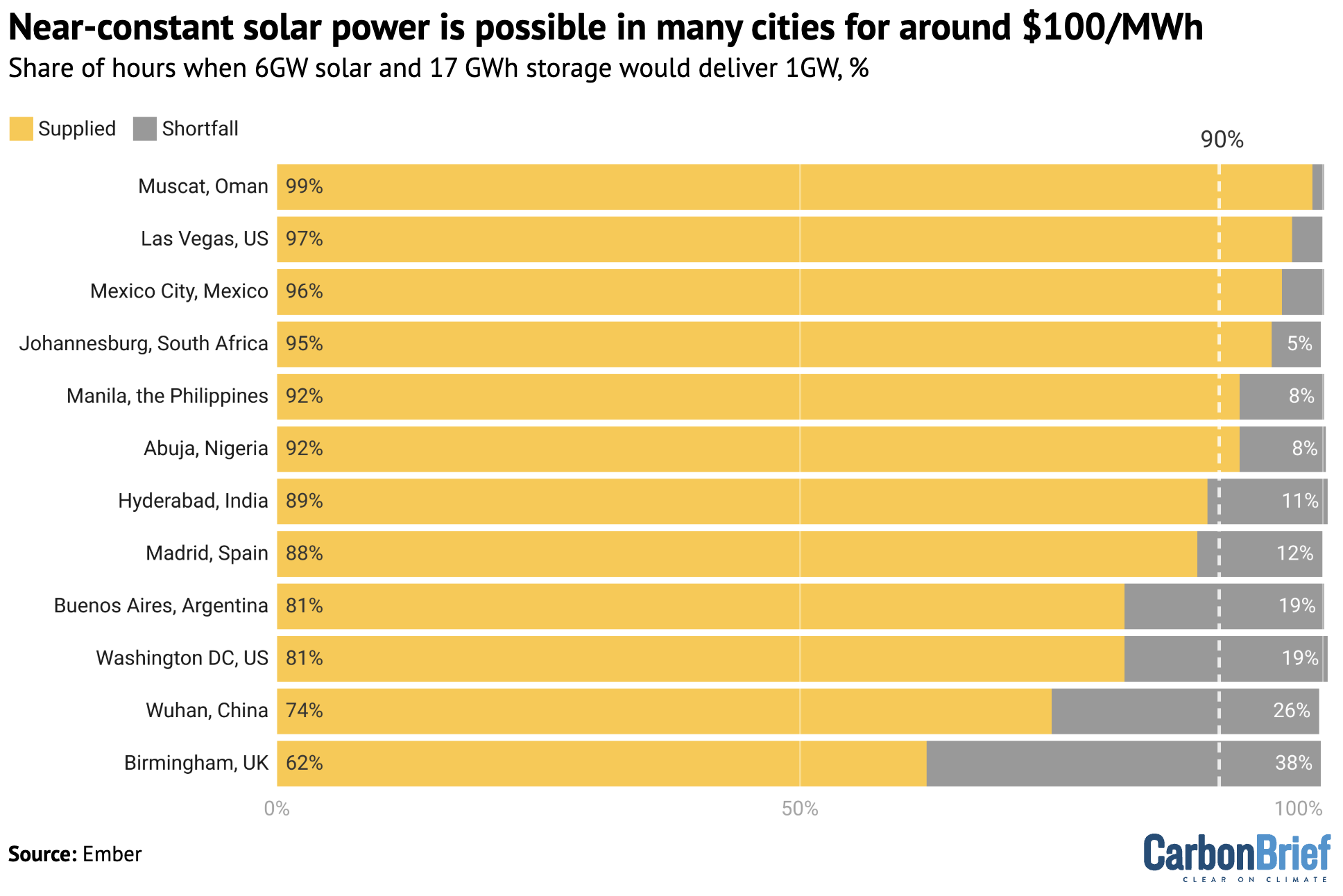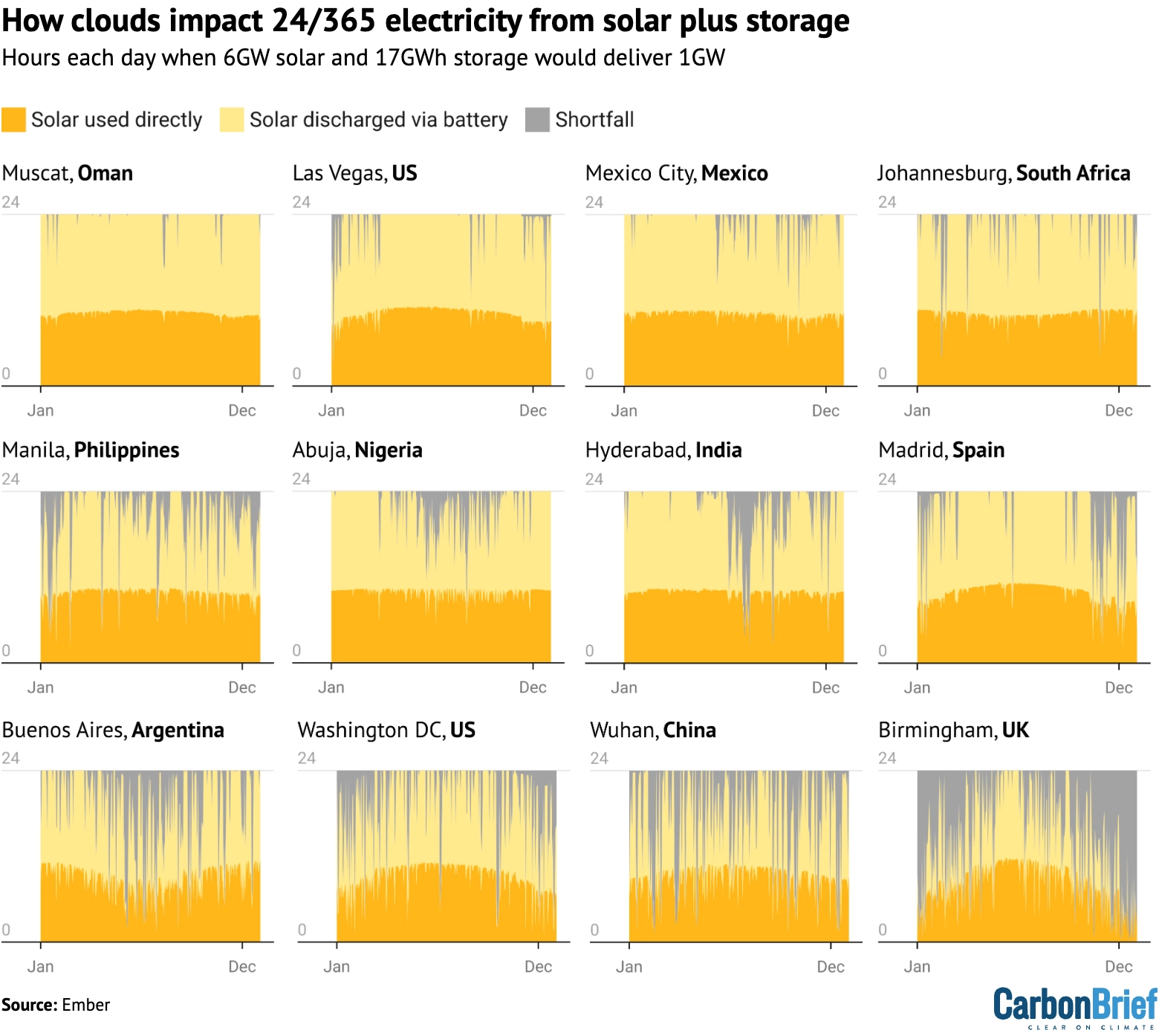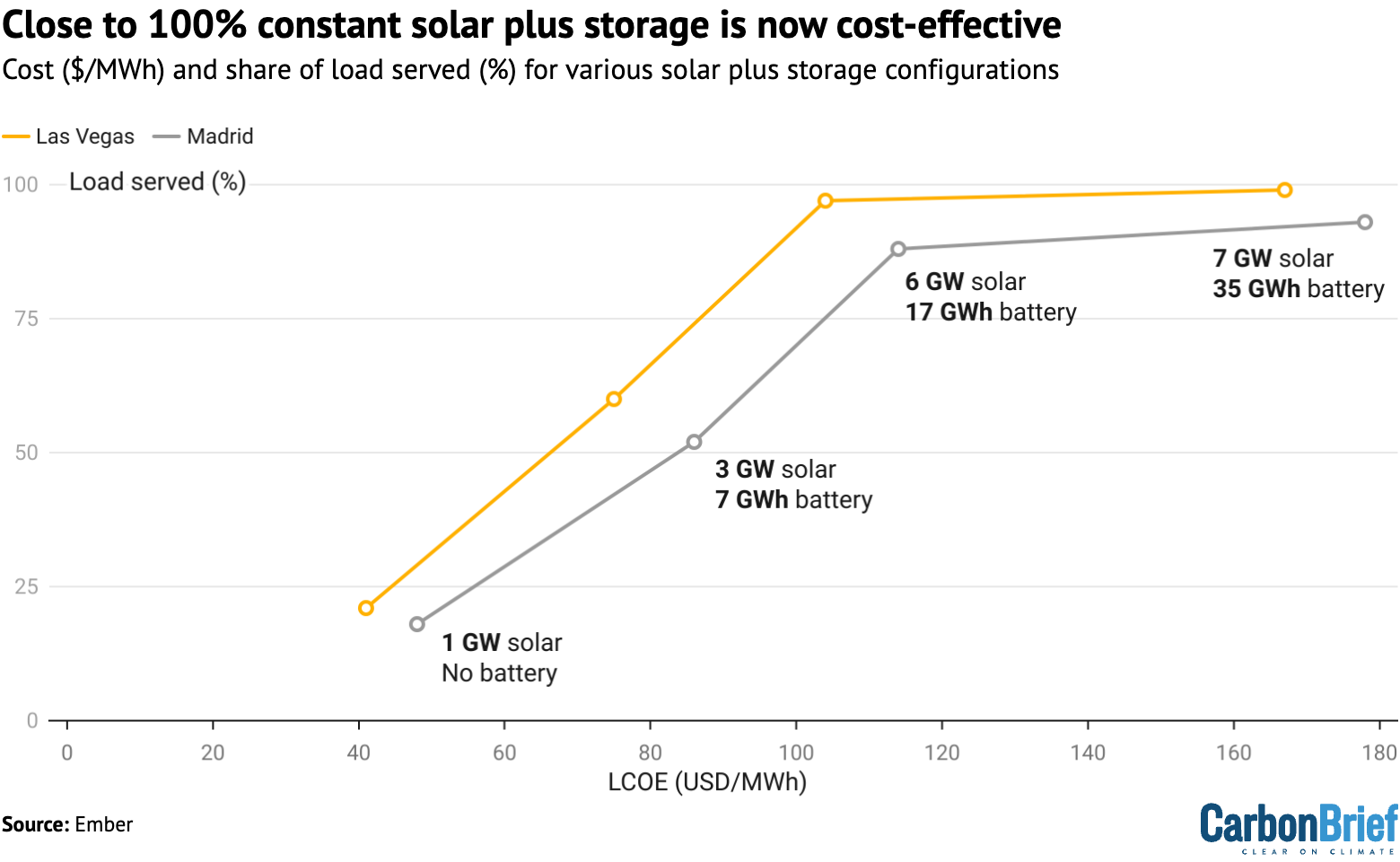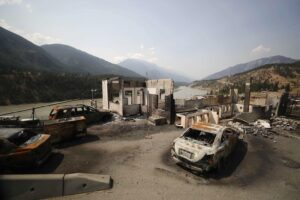A few years ago, solar power became the “cheapest electricity in history”, but it still lacked the ability to meet demand 24 hours a day and 365 days a year.
Since then, there have been significant improvements in the cost and performance of batteries, making it cheaper than ever to pair solar with energy storage using batteries.
In our new Ember “white paper”, we present modelling showing that solar with batteries in major sunny cities, such as Las Vegas or Mexico City, can now get more than 90% of the way to continuous generation, at costs below those of coal or nuclear power.
Even in cloudier cities away from the equator, such as Birmingham in the UK, it is possible to run on solar plus storage across the majority of hours in the year.
The white paper sets out how near-continuous “24/365” solar power has become an economic and technological reality in sunny regions.
Solar and storage ‘gamechangers’
A solar panel generates most electricity when the sun is shining, meaning it cannot provide constant power throughout the year. Put another way, 100 watts (W) of solar capacity only generates around 20W on average – and that output will be concentrated in daylight hours.
Our report shows that battery energy storage can unlock solar’s full potential, by turning daytime generation into around-the-clock electricity.
Indeed, when paired with sufficient battery storage, that same 100W of solar capacity can provide electricity around the clock – up to 100% of the time.
This also means up to five times as much solar generation can be delivered using the same connection to the electricity network, reducing the need for costly grid upgrades.
Battery energy storage is now cheaper than ever, with global average prices falling by 40% in 2024 alone. The cost of a full battery system fell to a record-low $165 per kilowatt hour (kWh), according to BloombergNEF.
Additionally, there have been a number of technological improvements boosting battery energy storage.
Recent innovations mean almost all grid batteries are now cobalt- and nickel-free, reducing the need for so-called “critical minerals”. They are longer-lasting than ever, with some batteries now having 20-year warranties. And they are safer than ever – with fire risk improving by a hundred-fold since 2019.
Improved container design has also cut maintenance and installation costs.
Our white paper shows that supply is ready to scale, with manufacturing capacity already exceeding demand. There is also significant new production capacity under construction outside of China.
The next frontier is sodium-ion “salt” batteries, which would eliminate the need for lithium and drive prices down even further. One large salt-battery plant has already been commissioned in China.
These technological advances and declining costs mean the world’s first “24/365” battery and solar plants are now coming online:
- In Hawaii, several solar-plus-battery projects are providing electricity through the night after the decommissioning of the last coal power plant in 2022.
- In the United Arab Emirates (UAE), at 100 megawatt (MW), Moro Hub is the world’s largest 100% solar-powered data centre, commissioned in 2022.
- In Saudi Arabia, a tourist mega project, including 16 hotel resorts that are all powered entirely by solar electricity, was completed in 2023.
- The first gigawatt-scale 24-hour solar project is already under development in the UAE. Emirati state-owned renewable energy company Masdar is leading the project, which was announced in January 2025 and will consist of a 5.2 gigawatt (GW) solar photovoltaic (PV) plant coupled with a 19 gigawatt hour (GWh) battery storage system to provide 1GW of uninterrupted solar electricity supply to the grid.
These examples show that 24/365 solar electricity has already been supplying customers and that it will increasingly start being used to power parts of the grid.
Cheaper in the sun
In order to investigate the potential for 24/365 solar, Ember’s white paper modelled a hypothetical system, using real weather data, for a series of cities around the world.
The modelling is based on a system with 6GW of solar capacity and 17GWh of battery storage, because there are roughly 15 hours of darkness in winter in the mid-latitudes.
The modelling shows that solar and battery in the sunniest cities could already get more than 90% of the way to 24/365 solar generation, covering almost every hour of every day in the year.
For example, Muscat in Oman could draw on 1GW of continuous solar electricity for 99% of hours in the year, if it paired 6GW of solar panels with 17GWh of battery capacity.
Las Vegas in the US, Mexico City in Mexico and Johannesburg in South Africa could all rely on such solar-plus-storage systems for at least 95% of hours in the year.
Even Birmingham in the UK could achieve 1GW of solar output for 62% of hours annually. (This is lower than for sunnier cities due to a stronger seasonal cycle and cloudier weather.)
In the sunniest places, solar and storage could generate reliable output, close to 24/365, for around $100 per megawatt hour (MWh), based on average global costs for solar and batteries in 2024.
For each city, the yellow shading in the figure below shows the share of hours each year that it could rely on 1GW of solar output if it installed a 6GW solar plus 17GWh battery system, given historical weather conditions.

Over the past year alone, the levelised cost of electricity (LCOE) for solar-plus-storage systems fell by 22%, driven by a 40% fall in battery prices. This is based on $165/kWh, which was BloombergNEF’s assessment of the global battery pack price at the end of 2024. The LCOE of solar and battery had fallen by 28% over the previous four years.
This makes solar with battery storage cheaper than both coal and nuclear when compared with US-based LCOE, as shown in the chart below.

There is evidence that 2025 solar and battery prices will continue to fall again. Already in early 2025, tenders for large-scale battery storage projects in Tabuk and Hail, Saudi Arabia, reported battery prices as low as $72/kWh.
Cloudy day challenges
Our modelling shows that the greatest challenge to generating constant, year-round electricity from solar plus storage is not nighttime, but clouds.
In the mid-latitudes, with around 15 hours of darkness in winter, around 17 hours of battery capacity is sufficient to bridge the period from sunset to sunrise.
This is because batteries typically do not fully charge and discharge to maintain high performance over time.
However, getting to 24/365 solar is harder, as while every day has daylight, not every day has full sunlight. Even though clouds do not reduce solar generation to zero – and despite batteries being cheaper than ever – extra battery storage is still not an economical option for bridging cloudy periods across multiple days.
The graphic below illustrates this, based on the same 6GW solar plus 17GWh storage system as described before, generating electricity under the weather conditions and seasonal cycles of the same 12 cities around the world.
The chart for each city runs from January to December on the horizontal axis and across 24 hours of each day on the vertical axis. Direct use of solar power is shown in orange, with stored solar from the battery shown in yellow and periods with a shortfall in dark blue.
The figure shows that, even on the cloudiest day of the year in Muscat, this solar-plus-storage system would generate constant electricity for 18 hours. Madrid in Spain would see lower output on some shorter and cloudier days in November, December and January. In contrast, Hyderabad in India would be impacted in the summer by cloudy monsoon days.
Overall, the figure shows that the sunniest cities would only fall slightly short of 24/365 solar electricity, but clouds would have a larger impact elsewhere.

The trade-off
The International Energy Agency (IEA) has described solar power as offering the “cheapest electricity in history”.
For example, solar power costs just $41/MWh in Las Vegas, according to Ember’s calculations using average global equipment and borrowing costs. However, this is only delivering electricity through daytime hours. As a result, on average around the world, solar has a “capacity factor” of 21% – meaning each unit of solar capacity generates 21% of its maximum theoretical output.
Raising this all the way to 97% raises the price to $104/MWh. However, this also substantially improves the value of solar, now that it is delivering close to 24/365. However, as the chart below shows, meeting the last few percent of demand from solar and storage alone significantly increases the price.
The best value between solar alone or solar with plentiful storage depends on the use case.
It may be optimal to build solar without a battery, so long as a factory can access cheap grid electricity when the solar panels are not generating, for example.
On the other hand, it may be optimal to build solar and batteries to get to 99.7% for an off-grid data centre that values reliability over price. Even in the most sunny places, exactly 100% supply will generally be uneconomic – but it is possible to get very close.

For many cases and based on current prices, the sweet spot may be to size the system for a constant supply of solar electricity for 60-90% of the time, our modelling suggests.
This provides cheap, low-carbon solar power most of the time. It would enable electricity to be used flexibly through the night or during high-price hours.
If widely deployed, such systems would allow for a significantly downscaled need for grid investment, whether they are large-scale solar farms exporting more electricity to the grid or industrial sites drawing from public supplies less often.
The post Guest post: How solar panels and batteries can now run ‘close to 24/365’ in some cities appeared first on Carbon Brief.
Guest post: How solar panels and batteries can now run ‘close to 24/365’ in some cities
Climate Change
DeBriefed 15 August 2025: Raging wildfires; Xi’s priorities; Factchecking the Trump climate report
Welcome to Carbon Brief’s DeBriefed.
An essential guide to the week’s key developments relating to climate change.
This week
Blazing heat hits Europe
FANNING THE FLAMES: Wildfires “fanned by a heatwave and strong winds” caused havoc across southern Europe, Reuters reported. It added: “Fire has affected nearly 440,000 hectares (1,700 square miles) in the eurozone so far in 2025, double the average for the same period of the year since 2006.” Extreme heat is “breaking temperature records across Europe”, the Guardian said, with several countries reporting readings of around 40C.
HUMAN TOLL: At least three people have died in the wildfires erupting across Spain, Turkey and Albania, France24 said, adding that the fires have “displaced thousands in Greece and Albania”. Le Monde reported that a child in Italy “died of heatstroke”, while thousands were evacuated from Spain and firefighters “battled three large wildfires” in Portugal.
UK WILDFIRE RISK: The UK saw temperatures as high as 33.4C this week as England “entered its fourth heatwave”, BBC News said. The high heat is causing “nationally significant” water shortfalls, it added, “hitting farms, damaging wildlife and increasing wildfires”. The Daily Mirror noted that these conditions “could last until mid-autumn”. Scientists warn the UK faces possible “firewaves” due to climate change, BBC News also reported.
Around the world
- GRID PRESSURES: Iraq suffered a “near nationwide blackout” as elevated power demand – due to extreme temperatures of around 50C – triggered a transmission line failure, Bloomberg reported.
- ‘DIRE’ DOWN UNDER: The Australian government is keeping a climate risk assessment that contains “dire” implications for the continent “under wraps”, the Australian Financial Review said.
- EXTREME RAINFALL: Mexico City is “seeing one of its heaviest rainy seasons in years”, the Washington Post said. Downpours in the Japanese island of Kyushu “caused flooding and mudslides”, according to Politico. In Kashmir, flash floods killed 56 and left “scores missing”, the Associated Press said.
- SOUTH-SOUTH COOPERATION: China and Brazil agreed to “ensure the success” of COP30 in a recent phone call, Chinese state news agency Xinhua reported.
- PLASTIC ‘DEADLOCK’: Talks on a plastic pollution treaty have failed again at a summit in Geneva, according to the Guardian, with countries “deadlocked” on whether it should include “curbs on production and toxic chemicals”.
15
The number of times by which the most ethnically-diverse areas in England are more likely to experience extreme heat than its “least diverse” areas, according to new analysis by Carbon Brief.
Latest climate research
- As many as 13 minerals critical for low-carbon energy may face shortages under 2C pathways | Nature Climate Change
- A “scoping review” examined the impact of climate change on poor sexual and reproductive health and rights in sub-Saharan Africa | PLOS One
- A UK university cut the carbon footprint of its weekly canteen menu by 31% “without students noticing” | Nature Food
(For more, see Carbon Brief’s in-depth daily summaries of the top climate news stories on Monday, Tuesday, Wednesday, Thursday and Friday.)
Captured
Factchecking Trump’s climate report

A report commissioned by the US government to justify rolling back climate regulations contains “at least 100 false or misleading statements”, according to a Carbon Brief factcheck involving dozens of leading climate scientists. The report, compiled in two months by five hand-picked researchers, inaccurately claims that “CO2-induced warming might be less damaging economically than commonly believed” and misleadingly states that “excessively aggressive [emissions] mitigation policies could prove more detrimental than beneficial”80
Spotlight
Does Xi Jinping care about climate change?
This week, Carbon Brief unpacks new research on Chinese president Xi Jinping’s policy priorities.
On this day in 2005, Xi Jinping, a local official in eastern China, made an unplanned speech when touring a small village – a rare occurrence in China’s highly-choreographed political culture.
In it, he observed that “lucid waters and lush mountains are mountains of silver and gold” – that is, the environment cannot be sacrificed for the sake of growth.
(The full text of the speech is not available, although Xi discussed the concept in a brief newspaper column – see below – a few days later.)
In a time where most government officials were laser-focused on delivering economic growth, this message was highly unusual.
Forward-thinking on environment
As a local official in the early 2000s, Xi endorsed the concept of “green GDP”, which integrates the value of natural resources and the environment into GDP calculations.
He also penned a regular newspaper column, 22 of which discussed environmental protection – although “climate change” was never mentioned.
This focus carried over to China’s national agenda when Xi became president.
New research from the Asia Society Policy Institute tracked policies in which Xi is reported by state media to have “personally” taken action.
It found that environmental protection is one of six topics in which he is often said to have directly steered policymaking.
Such policies include guidelines to build a “Beautiful China”, the creation of an environmental protection inspection team and the “three-north shelterbelt” afforestation programme.
“It’s important to know what Xi’s priorities are because the top leader wields outsized influence in the Chinese political system,” Neil Thomas, Asia Society Policy Institute fellow and report co-author, told Carbon Brief.
Local policymakers are “more likely” to invest resources in addressing policies they know have Xi’s attention, to increase their chances for promotion, he added.
What about climate and energy?
However, the research noted, climate and energy policies have not been publicised as bearing Xi’s personal touch.
“I think Xi prioritises environmental protection more than climate change because reducing pollution is an issue of social stability,” Thomas said, noting that “smoggy skies and polluted rivers” were more visible and more likely to trigger civil society pushback than gradual temperature increases.
The paper also said topics might not be linked to Xi personally when they are “too technical” or “politically sensitive”.
For example, Xi’s landmark decision for China to achieve carbon neutrality by 2060 is widely reported as having only been made after climate modelling – facilitated by former climate envoy Xie Zhenhua – showed that this goal was achievable.
Prior to this, Xi had never spoken publicly about carbon neutrality.
Prof Alex Wang, a University of California, Los Angeles professor of law not involved in the research, noted that emphasising Xi’s personal attention may signal “top” political priorities, but not necessarily Xi’s “personal interests”.
By not emphasising climate, he said, Xi may be trying to avoid “pushing the system to overprioritise climate to the exclusion of the other priorities”.
There are other ways to know where climate ranks on the policy agenda, Thomas noted:
“Climate watchers should look at what Xi says, what Xi does and what policies Xi authorises in the name of the ‘central committee’. Is Xi talking more about climate? Is Xi establishing institutions and convening meetings that focus on climate? Is climate becoming a more prominent theme in top-level documents?”
Watch, read, listen
TRUMP EFFECT: The Columbia Energy Exchange podcast examined how pressure from US tariffs could affect India’s clean energy transition.
NAMIBIAN ‘DESTRUCTION’: The National Observer investigated the failure to address “human rights abuses and environmental destruction” claims against a Canadian oil company in Namibia.
‘RED AI’: The Network for the Digital Economy and the Environment studied the state of current research on “Red AI”, or the “negative environmental implications of AI”.
Coming up
- 17 August: Bolivian general elections
- 18-29 August: Preparatory talks on the entry into force of the “High Seas Treaty”, New York
- 18-22 August: Y20 Summit, Johannesburg
- 21 August: Advancing the “Africa clean air programme” through Africa-Asia collaboration, Yokohama
Pick of the jobs
- Lancaster Environment Centre, senior research associate: JUST Centre | Salary: £39,355-£45,413. Location: Lancaster, UK
- Environmental Justice Foundation, communications and media officer, Francophone Africa | Salary: XOF600,000-XOF800,000. Location: Dakar, Senegal
- Politico, energy & climate editor | Salary: Unknown. Location: Brussels, Belgium
- EnviroCatalysts, meteorologist | Salary: Unknown. Location: New Delhi, India
DeBriefed is edited by Daisy Dunne. Please send any tips or feedback to debriefed@carbonbrief.org.
This is an online version of Carbon Brief’s weekly DeBriefed email newsletter. Subscribe for free here.
The post DeBriefed 15 August 2025: Raging wildfires; Xi’s priorities; Factchecking the Trump climate report appeared first on Carbon Brief.
DeBriefed 15 August 2025: Raging wildfires; Xi’s priorities; Factchecking the Trump climate report
Climate Change
New York Already Denied Permits to These Gas Pipelines. Under Trump, They Could Get Greenlit
The specter of a “gas-for-wind” compromise between the governor and the White House is drawing the ire of residents as a deadline looms.
Hundreds of New Yorkers rallied against new natural gas pipelines in their state as a deadline loomed for the public to comment on a revived proposal to expand the gas pipeline that supplies downstate New York.
New York Already Denied Permits to These Gas Pipelines. Under Trump, They Could Get Greenlit
Climate Change
Factcheck: Trump’s climate report includes more than 100 false or misleading claims
A “critical assessment” report commissioned by the Trump administration to justify a rollback of US climate regulations contains at least 100 false or misleading statements, according to a Carbon Brief factcheck involving dozens of leading climate scientists.
The report – “A critical review of impacts of greenhouse gas emissions on the US climate” – was published by the US Department of Energy (DoE) on 23 July, just days before the government laid out plans to revoke a scientific finding used as the legal basis for emissions regulation.
The executive summary of the controversial report inaccurately claims that “CO2-induced warming might be less damaging economically than commonly believed”.
It also states misleadingly that “excessively aggressive [emissions] mitigation policies could prove more detrimental than beneficial”.
Compiled in just two months by five “independent” researchers hand-selected by the climate-sceptic US secretary of energy Chris Wright, the document has sparked fierce criticism from climate scientists, who have pointed to factual errors, misrepresentation of research, messy citations and the cherry-picking of data.
Experts have also noted the authors’ track record of promoting views at odds with the mainstream understanding of climate science.
Wright’s department claims the report – which is currently open to public comment as part of a 30-day review – underwent an “internal peer-review period amongst [the] DoE’s scientific research community”.
The report is designed to provide a scientific underpinning to one flank of the Trump administration’s plans to rescind a finding that serves as the legal prerequisite for federal emissions regulation. (The second flank is about legal authority to regulate emissions.)
The “endangerment finding” – enacted by the Obama administration in 2009 – states that six greenhouse gases are contributing to the net-negative impacts of climate change and, thus, put the public in danger.
In a press release on 29 July, the US Environmental Protection Agency said “updated studies and information” set out in the new report would “challenge the assumptions” of the 2009 finding.
Carbon Brief asked a wide range of climate scientists, including those cited in the “critical review” itself, to factcheck the report’s various claims and statements.
The post Factcheck: Trump’s climate report includes more than 100 false or misleading claims appeared first on Carbon Brief.
https://www.carbonbrief.org/factcheck-trumps-climate-report-includes-more-than-100-false-or-misleading-claims/
-
Climate Change2 years ago
Spanish-language misinformation on renewable energy spreads online, report shows
-
Climate Change Videos2 years ago
The toxic gas flares fuelling Nigeria’s climate change – BBC News
-

 Greenhouse Gases1 year ago
Greenhouse Gases1 year ago嘉宾来稿:满足中国增长的用电需求 光伏加储能“比新建煤电更实惠”
-

 Climate Change1 year ago
Climate Change1 year ago嘉宾来稿:满足中国增长的用电需求 光伏加储能“比新建煤电更实惠”
-

 Carbon Footprint1 year ago
Carbon Footprint1 year agoUS SEC’s Climate Disclosure Rules Spur Renewed Interest in Carbon Credits
-
Climate Change2 years ago
Why airlines are perfect targets for anti-greenwashing legal action
-
Climate Change1 month ago
Guest post: Why China is still building new coal – and when it might stop
-
Renewable Energy2 months ago
US Grid Strain, Possible Allete Sale






